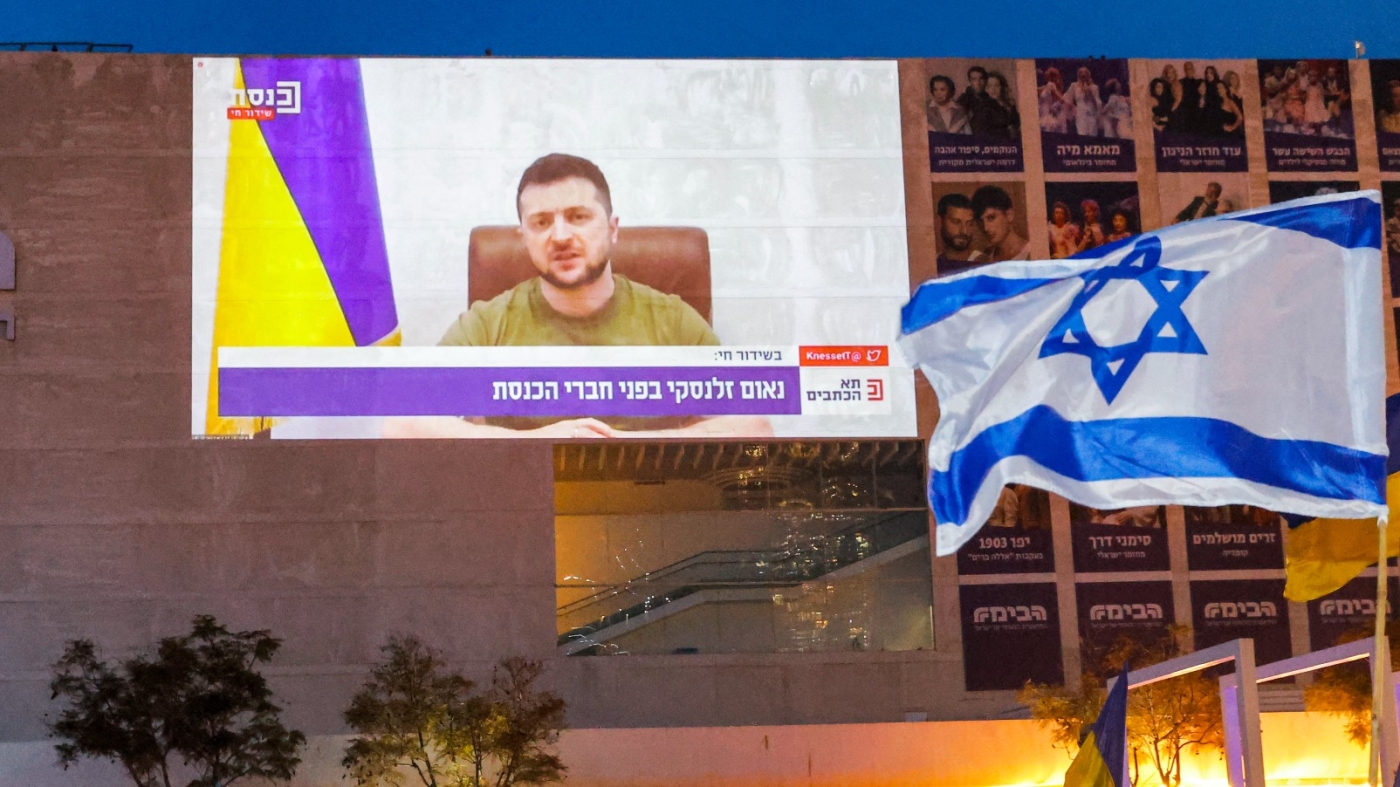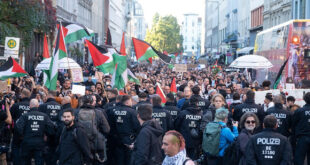March 25, 2022
The Ukrainian president should be reminded that the Palestinians are the people Ukrainian Jewish colonists displaced and whose land they stole.
A few days ago, Ukraine’s President Volodymyr Zelensky addressed the Knesset asking that Israel stand with Ukraine against the Russian invasion of his country.
He cited the Ukrainian Jewish colonist Golda Mabovitch (later Golda Meir), Israel’s former prime minister, who denied that the Palestinian people ever existed. Zelensky spoke of how Ukraine finds itself today in the same situation as Israel, namely that both countries seem to have horrible neighbours who “want to see us dead”.

Indeed, Israel has been most concerned about Ukrainian Jews, even before the Russian intervention began.
As early as January 2022, Israel began planning to transfer Ukrainian Jews to become colonists in the land of the Palestinians. Israel’s Ministry of Aliyah and Immigrant Absorption proclaimed: “We call on the Jews of Ukraine to immigrate to Israel – your home.”
The refugees/colonists began to arrive in early March, receiving preferential treatment, while Ukrainians who could not prove their Jewishness according to Israel’s racist criteria for refugees face myriad difficulties.
Meanwhile, the World Zionist Organization’s Settlement Division has begun preparing 1000 housing units for Ukrainian Jews on stolen and occupied Palestinian and Syrian land in the occupied West Bank and the occupied Golan Heights.
These Ukrainian refugees/colonists, however, are not the first Ukrainian Jews to colonise Palestine. Ukrainian Jews have played a pioneering role in the colonisation of Palestine since 1882.
A pioneering role
The story of southern Ukraine and of Ukrainian Jews is a principal part of the history of the colonisation of Palestine. It begins in the late 18th century when Catherine the Great (a German Lutheran who converted to Orthodoxy to become Tsarina) defeated the Ottomans in the Russo-Ottoman war of 1768-1774.Ukrainians fleeing to Israel will transform overnight into settlers and colonisersRead More »
This led to the signing of the Kuchuk Kainarji peace treaty, and lost the Ottomans sovereignty over the northern Caucasus, including the Crimea and Kuban regions, saddling Istanbul with thousands of Tatar refugees. Catherine immediately embarked on the settler-colonization of these areas.
The first wave of Russian settlers arrived in 1778 and elicited an immediate revolt by the Crimean Tatars, which Catherine put down before she formally annexed the Crimea in 1783.
The Russian-Ottoman war of 1787-1792 led to another Ottoman defeat and loss of territory, including the Sanjak of Ozi on the northern parts of the Black Sea, adjacent to Crimea. Russification of what was now called “New Russia” ensued.
The Black Sea Ottoman town of Hacibey was expanded into a new settler-colony established by the Russians and named “Odessa” in 1794, on the mistaken presumption that the ancient Greek colony of Odessos had existed there, which ironically it did not.
Catherine’s philhellenist christening of Hacibey with a Greek name was intended to “dazzle everyone with the brilliant achievements of the Great Catherine… [and] the first step toward ridding Europe of the Mohammedans and conquering Istanbul.”
On the Crimean Peninsula, Catherine established the city of Sebastopol in 1783 (also christening it with a Greek name) on the site of the Tatar town of Akhtiar and renamed the Tatar town of Aqmescit (meaning White or Western Mosque) Simferopol in 1784.
Crimea itself was renamed the “Tauride Governorate” in honour of the ancient Greek Tauris. Other Greek-named colonies included Olviopol, Tiraspol, Melitopol, Nikopol, Grigoriopol, Aleksopol, and Mariupol.
Between Odessa and Palestine
In 1804, the Russian government’s “Regulation on the Jews” promised 10 years of subsidies and tax exemptions to former-Polish-turned-Russian Jews willing to undertake settler-colonisation in the occupied Ottoman regions.
By 1810, 10,000 landless Jews from Russia’s Belorussia and Lithuania regions were dispatched to the Kherson Province on the Black Sea, named by Catherine after the ancient Greek colony of Chersonesus after its conquest from the Ottomans.
Following the anti-Jewish pogroms of the early 1880s, calls on Russia’s Jews to leave to Palestine multiplied
By the 1820s a fresh wave of Jewish colonists settled in Kherson and the neighbouring Ekaterinoslav Province (named in honour of Catherine after its conquest from the Ottomans), and more arrived in the late 1830s and 1840s, officially designated as “Jewish-agriculturalists“. By 1859, the ministerial plan of turning Jews into farmers seemed not to have succeeded, and as a result new Jewish colonial settlement in New Russia was officially halted in 1866, while preserving the existing Jewish colonies.
In the meantime, Odessa had grown to encompass the largest urban Jewish population in imperial Russia alongside Warsaw. It was in fact in Odessa where the Jewish Haskalah Hebrew press began to encourage Jewish intellectuals to embark on the settler-colonisation of Palestine.
Odessa’s origins as a colonial settlement, it would seem, had much influence on the intellectual classes raised in the city.
The Greek intellectuals who started the movement for Greek independence and formed the nationalist organisation “Philiki Etairia”(Friendly Society) in the early 19th century also hailed from the settler-colonial Greek community of Odessa.
By the late 19th century and early 20th centuries, Odessa – a third of whose population was by then Russian, West Ukrainian and Polish-Jewish colonial settlers and their descendants – became a major centre of Zionist activity.
Following the anti-Jewish pogroms of the early 1880s, calls on Russia’s Jews to leave to Palestine multiplied. While two million would go to the Americas and Western Europe in the next two decades, a trickle of a few thousand would go to colonize Palestine.
Moses L Lilienblum (1843-1910), who was born in Lithuania and arrived as a settler in Odessa in 1869, became in 1884 the leader of the first proto-Zionist settler-colonial movement, namely “Hovevei Tsiyon” or Lovers of Zion, founded in Odessa in 1882. Lilienblum believed that Jews were “a distinct racial and national entity” and that all Russian Jews should be transferred to Palestine to establish agricultural colonies there.
Zionism’s birthplace
Odessa was also the birthplace of top Zionist leaders, including most prominently Vladimir Yevgenyevich Zhabotinsky (later renamed “Ze’ev” Jabotinsky), founder of Revisionist Zionism, and himself a direct descendant of Ukrainian Jewish settlers in Odessa. His father Yevgeni “Yona” Grigorievitch was from the Ukrainian town of Nikopol and his mother Eva Zak from the Ukrainian shtetl of Berdychiv.
The French-German Jewish banker and philanthropist Baron Edmond de Rothschild financed the Hovevei Tsiyon movement’s colonies in Palestine, including its first colony in “Rishon le Zion” (meaning First to Zion) in 1882.
In 1890, the movement registered in Russia as a charitable organisation, based in Odessa, under the name “The Society for the Support of Jewish Farmers and Artisans in Syria and Palestine”.
It was headed by the Russian Jewish doctor and activist Leo Pinsker, author of the 1882 book Autoemancipation that supported the transformation of Russia’s Jews into colonists.
Hovevei Tsiyon would help establish two more settler-colonies in the 1890s in Palestine, including Rehovot and Hadera (in the latter, they imported hundreds of Egyptian and Sudanese labourers to dry the marshes for them, scores of whom died from malaria). It counted 4000 Jews, most of whom later joined the Zionist Organization (ZO) which Theodor Herzl founded in 1897.
As early as 1884, Palestinian peasants revolted against the theft of their lands and their displacement, and attacked several Ukrainian Jewish colonies, including Hadera and Rehovot. Hovevei Tsiyon colonists continued their activities until the organisation was closed down in 1913 as the colonies became part of the ZO colonial project.
Jewish colonies were also established in the Crimea by the Tsars. In the wake of the Russian revolution, Jews were targeted with horrific pogroms which devastated the Pale of Settlement territories where they lived and destroyed their local economy. The Soviets, in partnership with American Jewish bankers-philanthropists who set up “The American Joint Agricultural Corporation“, would continue to fund and expand Jewish colonies in the Crimea in the 1920s and 1930s despite vehement local Tatar opposition.
When the Nazis invaded, the Soviet government evacuated as many Jews as it could, including from southern Ukraine and the Crimea behind Red Army lines to protect them. Those who remained were killed by the Nazis and their Ukrainian nationalist collaborators.
When Western Ukraine, Latvia, Lithuania, and Moldavia were re-annexed by Stalin after 1940, the Jews of these regions remained more open to Zionist influence as a result of a wave of antisemitism that dominated these countries after the first World War.
Israel’s neighbours
Israel and the US pressured the Soviets in the late 1960s and 1970s about alleged Soviet antisemitism (which is how they described the Soviet crackdown on Zionist activities at the time) for not allowing Soviet Jews to emigrate, when in fact Soviet limits on emigration applied to all Soviet citizens.
The Soviets relented in the 1970s and allowed those Soviet Jews who wanted to emigrate to do so. Most hailed from Western Ukraine, Latvia, Moldavia and Lithuania, and the majority wanted to go to the United States, which led Israel to limit their options and force them to go to Israel as the only possible destination. However more than half of the emigrants settled in the US despite Israeli obstruction.
All of this preceded the arrival of one million Russian and Ukrainian Jews in the 1990s to Israel, many of whom turned out not to be “Jewish” according to Israeli law, not to mention Jewish religious law, where they proceeded to colonise the land of the Palestinians.
When President Zelensky complained about Israel’s neighbours, he should have been reminded that the Palestinians are not the accidental neighbours of Ukrainian Jewish colonists, but the people Ukrainian Jewish colonists displaced and whose land they stole.
Yet, it was the very same Zelensky who withdrew Ukraine’s membership from the UN Committee on the Exercise of the Inalienable Rights of the Palestinian People in 2020. As Israel was killing and bombing Palestinians in May 2021, Zelensky depicted it as the victim of the Palestinians and not as a predatory settler-colonial state which Ukrainian Jews helped establish.
Ironically, that Zelensky thinks Israel’s neighbours “want to see us dead” may be no more than a psychological projection of what he and the Israelis want to see happen to Palestinians, not the other way around.
* Joseph Massad is a professor of modern Arab politics and intellectual history at Columbia University, New York.
 Arabgazette Arabgazette Magazine
Arabgazette Arabgazette Magazine


